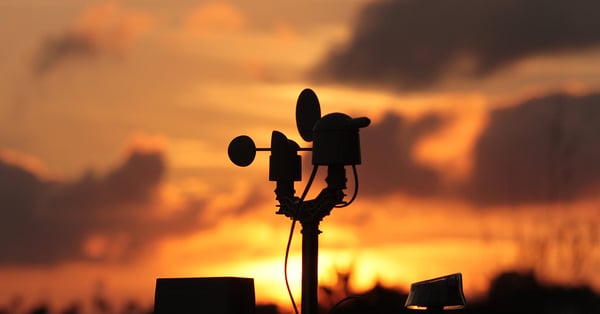Barometric pressure is one of the most misunderstood of all pressure types. A barometric pressure sensor is a useful device in many applications including aviation, weather forecasting, medical and even auto racing, to name a few. Barometers are used as key indicators in many applications and there are specific adjustments required for each practice.
Barometric pressure is created by the atmosphere in the gravitational field of the Earth. Imagine a column of air from the ground extending vertically up to the area between our atmosphere and outer space. The force per unit area created by this column of air, at any point, is the barometric pressure. Every molecule in this column is subjected to gravity. The weight of the gas above any point in the column creates a higher density and pressure as the elevation decreases. The highest value of barometric pressure is at the bottom of this column and decreases, as altitude increases, to its lowest value (the reference value) of zero pressure or vacuum in outer space.Among the various applications of barometric pressure, this article focuses on two applications, aviation and weather stations, which require significantly different adjustments compared to one another.
Barometric Pressure Readings in Aviation
An altimeter is a piece of equipment present in abundance in the aviation industry. It uses barometric pressure to deliver an altitude reading. Altitude is the height above sea level. On any given day, the barometric pressure at any altitude will fluctuate depending on weather. To convert the pressure (P) reading to altitude (A), a mathematical function is used, A = f (P), where "f" is derived from the International Standard Atmosphere (ISA), which is a model of how pressure changes over a wide range of altitude.
In addition, an offset must be entered to adjust for changes in atmospheric pressure relative to standard sea level pressure for that day. This adjustment is necessary so the altimeter will read the correct altitude of the runway. These altitude readings are crucial for a pilot to measure where the sky ends and the ground starts. The altimeter reading is adjusted to the barometric pressure of the destination airport, and it may be significantly different to the barometric pressure where the flight originated from.
Barometric Pressure Readings in Meteorology
Atmospheric pressure is one of several parameters used to analyze weather systems. The movement, circulation, temperature, and general impact of these systems can be predicted by analyzing data on temperature and pressure across the globe. In the northern hemisphere, low pressure weather cyclones rotate counterclockwise around a low pressure area. The pressure at the center and the degree to which the pressure changes from the center to the outside is a measurement of the strength and severity of the system.
Meteorologists measure the strength and gradient of pressure changes using isobars. Isobars are lines on a map connecting points having the same atmospheric pressure. To standardize these isobar lines, the pressure must be adjusted to mean sea level, otherwise the effect of altitude at the point where the pressure is measured would skew the results when compared to the entire system. Mean sea level pressure is the pressure the weather station would report, if it was moved down to sea level.
Mean sea level pressure is generally higher than your measured pressure. The formula used for this correction is derived from the International Standard Atmosphere:
P0 = P1 (1 - (0.0065h/ (T + 0.0065h + 273.15))-5.257
P0 is the calculated mean sea level value in hPa, P1 is the actual measured pressure (station Pressure) in hectopascal (hPa), T is the temperature in degree Celcius (°C), and h is the elevation in meters (m).
 A typical weather station setup; Photo by @penninck via Twenty20
A typical weather station setup; Photo by @penninck via Twenty20
If your application requires that you know the actual air pressure at your location referenced to vacuum, the density of the air or total amount of constituent gas molecules, the absolute pressure is the best indicator. Absolute pressure is the actual pressure at your location in reference to absolute zero or vacuum. In weather forecasting this is called station pressure.
Essentially, barometric pressure is used in plenty of systems and applications around the world. Depending on where and how it's used, the adjustments applied to it could be in reference to a location, sea level or vacuum pressure. It's important to understand the differences in these adjustments and their impact on the readout from your barometric sensor.
Related Reading:


